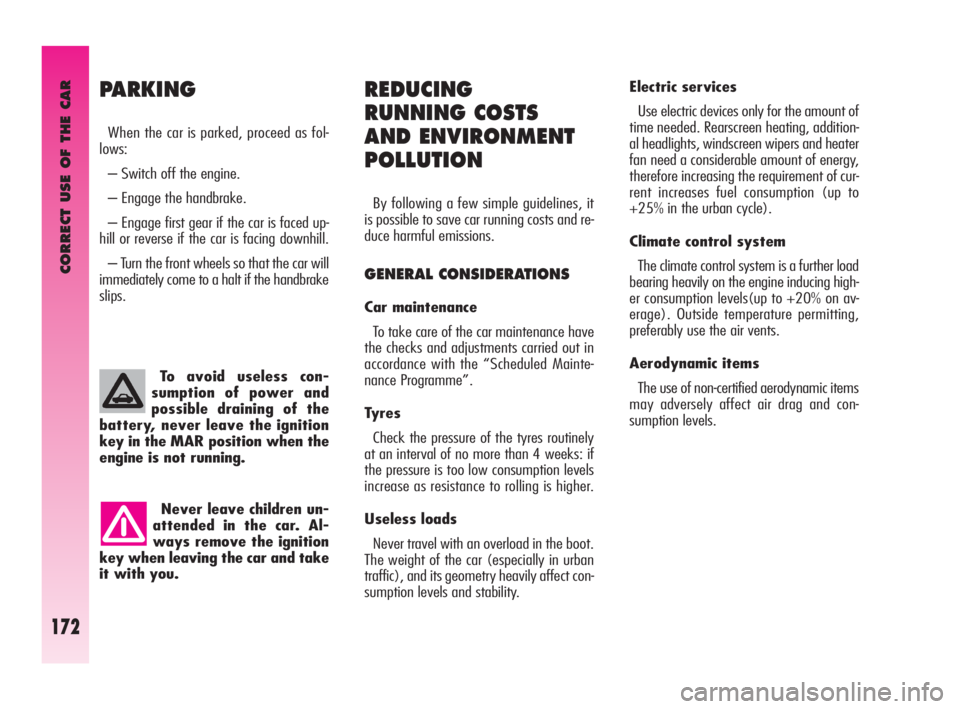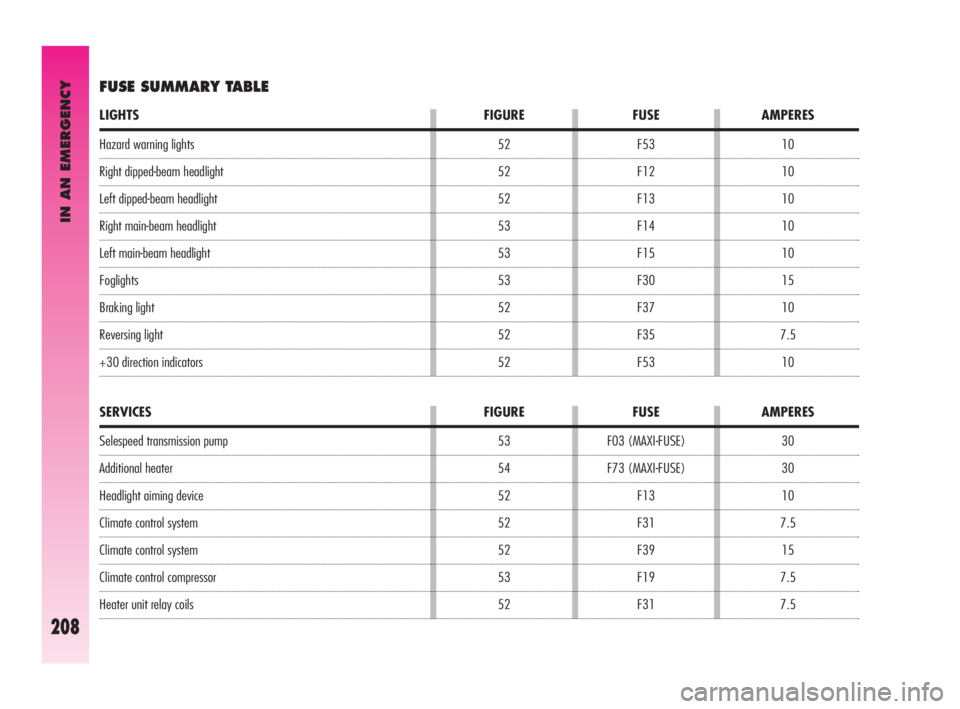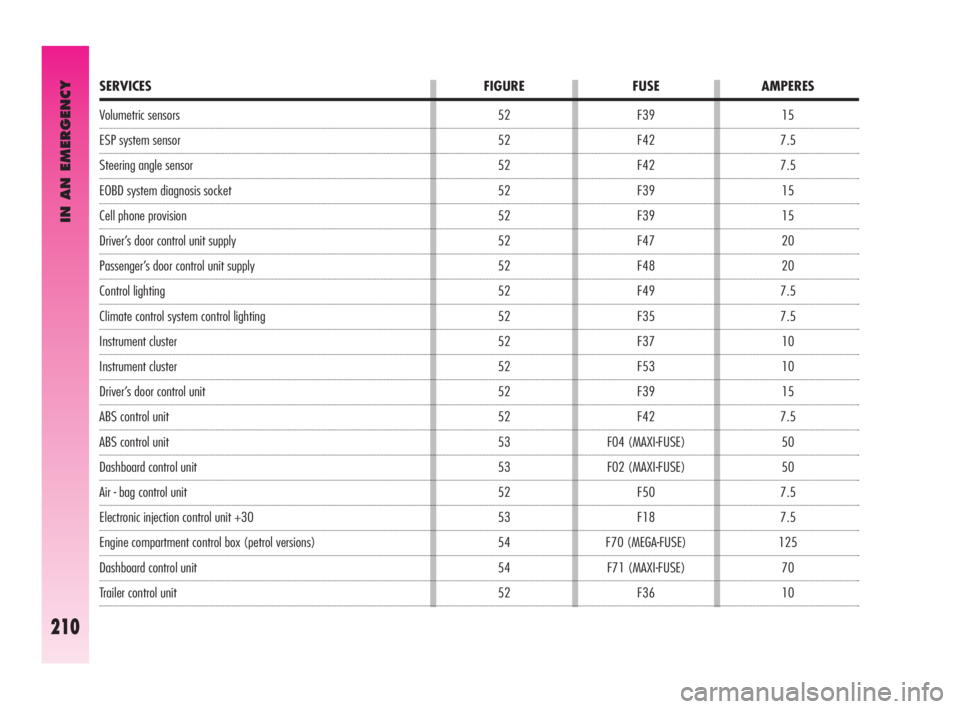ESP Alfa Romeo GT 2009 Owner handbook (in English)
[x] Cancel search | Manufacturer: ALFA ROMEO, Model Year: 2009, Model line: GT, Model: Alfa Romeo GT 2009Pages: 271, PDF Size: 5.34 MB
Page 174 of 271

CORRECT USE OF THE CAR
172
Never leave children un-
attended in the car. Al-
ways remove the ignition
key when leaving the car and take
it with you.To avoid useless con-
sumption of power and
possible draining of the
battery, never leave the ignition
key in the MAR position when the
engine is not running.
PARKING
When the car is parked, proceed as fol-
lows:
– Switch off the engine.
– Engage the handbrake.
– Engage first gear if the car is faced up-
hill or reverse if the car is facing downhill.
– Turn the front wheels so that the car will
immediately come to a halt if the handbrake
slips.
REDUCING
RUNNING COSTS
AND ENVIRONMENT
POLLUTION
By following a few simple guidelines, it
is possible to save car running costs and re-
duce harmful emissions.
GENERAL CONSIDERATIONS
Car maintenance
To take care of the car maintenance have
the checks and adjustments carried out in
accordance with the “Scheduled Mainte-
nance Programme”.
Tyres
Check the pressure of the tyres routinely
at an interval of no more than 4 weeks: if
the pressure is too low consumption levels
increase as resistance to rolling is higher.
Useless loads
Never travel with an overload in the boot.
The weight of the car (especially in urban
traffic), and its geometry heavily affect con-
sumption levels and stability.Electric services
Use electric devices only for the amount of
time needed. Rearscreen heating, addition-
al headlights, windscreen wipers and heater
fan need a considerable amount of energy,
therefore increasing the requirement of cur-
rent increases fuel consumption (up to
+25% in the urban cycle).
Climate control system
The climate control system is a further load
bearing heavily on the engine inducing high-
er consumption levels(up to +20% on av-
erage). Outside temperature permitting,
preferably use the air vents.
Aerodynamic items
The use of non-certified aerodynamic items
may adversely affect air drag and con-
sumption levels.
Page 181 of 271

IN AN EMERGENCY
179
3) Fully depress the accelerator pedal and
keep it pressed. The
Uwarning light will
come on for eight seconds and then go off,
now release the accelerator pedal.
4) The
Uwarning light begins to flash:
after it has flashed the same number of
times as the first digit on the CODE card,
press the accelerator pedal and keep it
pressed until the
Uwarning light turns on
(for four seconds) and then goes off; now
release the accelerator pedal.
5) The
Uwarning light starts to flash: af-
ter the number of flashes corresponding to
the second digit on the CODE card, press the
accelerator pedal and keep it pressed.
6) Repeat this procedure for the remain-
ing digits on the CODE card.
7) After entering the last figure, keep the
accelerator pedal pressed. The
Uwarning
light turns on (for four seconds) and then
goes off; now release the accelerator pedal. 8) A quick flash of the
Uwarning light
(for about four seconds) confirms that the
operation has been carried out correctly.
9) Start the engine turning the ignition key
fromMARtoAV Vwithout returning the
key to the STOPposition.
Conversely, if the
Uwarning light stays
on, turn the key to STOPand repeat the
procedure starting from point 1).
IMPORTANTAfter emergency starting
it is advisable to contact Alfa Romeo Au-
thorised Services, because the emergency
procedure must be repeated each time the
engine is started.
EMERGENCY
STARTING
If it is not possible to deactivate the engine
inhibitor with the Alfa Romeo CODE system,
the
YandUwarning lights stay on and
the engine will not start. Emergency start-
ing is needed to start the engine.
IMPORTANTYou are advised to care-
fully read the entire procedure before carry-
ing it out. If a mistake is made during the
emergency procedure, the ignition key should
be turned to STOPand the operations must
be repeated from the start (point 1).
1) Read the 5-figure electronic code on the
CODE card.
2) Turn the ignition key to MAR.
I I
N N
A A
N N
E E
M M
E E
R R
G G
E E
N N
C C
Y Y
In an emergency we recommend that you call the freephone number found in the Warranty Booklet.
You can also consult www.alfaromeo.com to find Alfa Romeo Authorised Services your nearest
Page 186 of 271

IN AN EMERGENCY
184
– Using the wrench provided (A-fig. 5),
loosen the fastening bolts by about one turn.
– Set the jack under the car, near the
wheel to be changed taking care not to dam-
age the plastic streamlined guard.
– Work the jack crank (A-fig. 6), to ex-
tend it until the groove (B) on the upper
part of jack is correctly inserted on the low-
er profile of the body (C) approx. 40 cm
from the profile of the wheelhouse.
– Work the jack and raise the car until the
wheel is a few centimetres from the ground.
– Completely unscrew the fastening bolts
and remove the wheel.– Make sure that the contact surfaces of
the spare wheel with the hub are clean and
free of impurities which may later cause the
fastening bolts to slacken.
– Install the spare wheel matching the
hole (A-fig. 7) with the corresponding pin
(B).
– Using the wrench provided, fasten the
five bolts.
– Lower the car and remove the jack.
– Using the wrench provided, fully tighten
the bolts in the sequence shown in fig. 8.REFITTING
A NORMAL WHEEL
– Following the procedure described pre-
viously, raise the car and remove the spare
wheel.
For versions with steel rims:
– Fit the normal wheel matching the hole
(A-fig. 7) with the corresponding pin (B).
– Make sure that the contact surfaces of
the wheel with the hub are clean and free
of impurities which may later cause the fas-
tening bolts to slacken.
fig. 5
A0A0694b
fig. 6
A0A0695b
Page 195 of 271

IN AN EMERGENCY
193
D.-E. Halogen bulbs
To remove, free it from the clip on
its housing.
F. Gas-discharge bulbs
(Xenon)
To remove the bulb, slacken the fas-
tening ring nut and release the re-
taining ring.GENERAL INSTRUCTIONS
– When a light is not working, check that
the corresponding fuse is intact before
changing a bulb.
– For the location of fuses, refer to the
paragraph “In the event of a burnt fuse”
in this chapter.
– Before changing a bulb check the con-
tacts for oxidation.
– Burnt bulbs must be replaced by oth-
ers of the same type and power.
– Always check headlight aiming after
changing a bulb to ensure they are safe.
TYPES OF BULBS (fig. 21)
Various types of bulbs are fitted to your car:
A. All glass bulbs
These are pressed on. Pull to remove.
B. Bayonet type bulbs
Press the bulb, turn counter-clockwise
to remove this type of bulb from its
holder.
C. Tubular bulbs
Free them from their contacts to re-
move.
fig. 21
A0A0503b
Page 204 of 271

IN AN EMERGENCY
202
REAR ROOF LIGHT
(fig. 41-42)
To change the bulb, proceed as follows:
– Remove the light unit (A) levering in
the point shown by the arrow.
– Replace the bulb releasing it from the
side contacts making sure that the new bulb
is correctly clamped between the contacts.– Refit the light unit in the correct position
inserting first the side with the connector,
then pressing the other side until the catch
clicks into place (B).
fig. 41
A0A0177b
fig. 42
A0A0178b
– Close the protective cover (B).
– Refit the light unit pressing gently in cor-
respondence with the retainer catches, un-
til hearing the click.
fig. 40
A0A0176b
Page 210 of 271

IN AN EMERGENCY
208
30
30
10
7.5
15
7.5
7.5 F03 (MAXI-FUSE)
F73 (MAXI-FUSE)
F13
F31
F39
F19
F31
SERVICES FIGURE FUSE AMPERES
Hazard warning lights
Right dipped-beam headlight
Left dipped-beam headlight
Right main-beam headlight
Left main-beam headlight
Foglights
Braking light
Reversing light
+30 direction indicators10
10
10
10
10
15
10
7.5
10 F53
F12
F13
F14
F15
F30
F37
F35
F53
LIGHTS FIGURE FUSE AMPERES
FUSE SUMMARY TABLE
Selespeed transmission pump
Additional heater
Headlight aiming device
Climate control system
Climate control system
Climate control compressor
Heater unit relay coils52
52
52
53
53
53
52
52
52
53
54
52
52
52
53
52
Page 211 of 271

IN AN EMERGENCY
209
15
15
7.5
15
15
30
30
20
15
7.5
7.5
20
20
15
7.5
15
7.5 F32
F32
F51
F39
F39
F40
F43
F44
F45
F41
F35
F38
F09
F39
F17
F11
F49
SERVICES FIGURE FUSE AMPERES
Key-operated +30
Selespeed transmission
Selespeed transmission
Radio
Navigator
Rearscreen heating
Windscreen - rearscreen washer (pump)
Cigar lighter
Seats with electric heating
Heated wing mirrors – heated nozzles
Cruise control
Central door locking
Headlight washer
Services + 30
Primary services (electronic injection)
Secondary services (electronic injection)
Secondary services52
52
52
52
52
52
52
52
52
52
52
52
53
52
53
53
52
Page 212 of 271

Volumetric sensors
ESP system sensor
Steering angle sensor
EOBD system diagnosis socket
Cell phone provision
Driver’s door control unit supply
Passenger’s door control unit supply
Control lighting
Climate control system control lighting
Instrument cluster
Instrument cluster
Driver’s door control unit
ABS control unit
ABS control unit
Dashboard control unit
Air - bag control unit
Electronic injection control unit +30
Engine compartment control box (petrol versions)
Dashboard control unit
Trailer control unit15
7.5
7.5
15
15
20
20
7.5
7.5
10
10
15
7.5
50
50
7.5
7.5
125
70
10 F39
F42
F42
F39
F39
F47
F48
F49
F35
F37
F53
F39
F42
F04 (MAXI-FUSE)
F02 (MAXI-FUSE)
F50
F18
F70 (MEGA-FUSE)
F71 (MAXI-FUSE)
F36 52
52
52
52
52
52
52
52
52
52
52
52
52
53
53
52
53
54
54
52
SERVICES FIGURE FUSE AMPERES
IN AN EMERGENCY
210
Page 217 of 271

IN AN EMERGENCY
215
– In motorways pileups, especially with
poor visibility, the risk of being involved in
other crashes is high. Leave the car imme-
diately and go beyond the guard-rail.
– If doors are blocked, do not try to get
out of the car breaking the windscreen which
is stratified. The windows and rear screen
are easier to break.
– Remove the ignition key of the cars in-
volved.
– If you note a smell of fuel or other chem-
ical products, do not smoke and have a cig-
arette stubbed out.
– To put out fires, even small ones, use
the extinguisher, blankets, sand, or earth.
Never use water.
– If use of the lighting system is not nec-
essary, disconnect the battery negative ter-
minal (–).IN THE EVENT
OF AN ACCIDENT
– It is important to keep calm.
– If you are not directly involved, stop at
least a few dozen metres away from the ac-
cident.
– On motorways, stop without blocking
the emergency lane.
– Turn the engine off and the hazard warn-
ing lights on.
– At night, illuminate the place of the ac-
cident with the headlights.
– Take care, do not risk being run over.
– Signal the accident placing the triangle
at regulation distance in a clearly visible
place.
– Call the emergency organisation, giving
the most accurate information possible. On
motorways use the special phones provid-
ed.
IF PEOPLE ARE INJURED
– An injured person must never be aban-
doned. Helping is compulsory also for per-
sons not directly involved in the accident.
– Do not crowd around injured people.
– Reassure the injured person that help
is on the way, and stay near to overcome
any panic.
– Release or cut the seat belt restraining
injured persons.
– Do not give injured persons anything
to drink.
– An injured person should never be
moved except in the following circum-
stances.
– Remove an injured person from the car
only in danger of fire, sinking or falling.
When removing an injured person: do not
pull the limbs or bend the head and keep
the body as horizontal as possible.
FIRST AID KIT
In addition to the first-aid kit, it is also
wise to keep an extinguisher and a blan-
ket in the car.
Page 220 of 271

●●●●●●●●●
●●
●●●●
●●●●
●●
●
●●●
●
●
●
●●●●●●●●●
●●●●●●●●●
●●●
●●●●●●●●●
●●●●●●●●●
CAR MAINTENANCE
218
20 40 60 80 100 120 140 160 180Thousands of km
Check and if necessary top up the Selespeed automatic transmission oil level
(2.0 JTS versions)
Sight check for conditions of timing gear drive toothed belt (3.2 V6 and JTD versions)
Check emissions/smoke at the exhaust (JTD versions)
Check operation of engine control system (through diagnosis socket)
Check mechanical transmission oil level
Change counter-rotating shaft drive belt
Change timing gear drive belt (1.8 T.SPARK and 2.0 JTS versions) (*)
Change timing gear drive belt (3.2 V6 and JTD versions) (*)
Change accessory poly-V drive belt
Change spark plugs (petrol versions)
Change engine oil and oil filter (petrol versions) (or every 24 months)
Change engine oil and oil filter (diesel with DPF versions)(**)
(or every 24 months)
Change engine oil and oil filter (diesel without DPF versions)(**)
(or every 24 months)
Change brake fluid (or every 24 months)
Change fuel filter (JTD versions)
Change pollen filter (or every year)
(*) Regardless of the km covered, the timing belt shall be replaced every 4 years for particularly demanding use (cold climates, driving in the city, idling for a long time) or in any case every 5 years.
(**) Engine oil and oil filter shall actually be changed according to the conditions of use of the car and it is indicated by the relevant warning light or message (where provided) on the instrument panel
(see “Warning lights and messages” paragraph).
If the car is used mainly on urban routes or if the yearly kilometres travelled are less than 10,000 km, the engine oil and filter must be changed every 12 months.